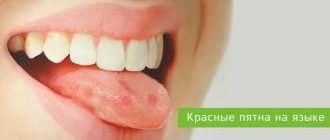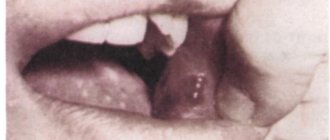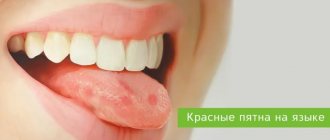Dental practice confirms that most people's bite is not ideal. Sometimes parents pay attention to this problem from the first years of a child’s life, children of less attentive parents turn to orthodontic treatment when they reach adulthood, while many, attributing the problem solely to aesthetic imperfections, prefer to ignore it altogether.
In fact, in addition to a visual defect, an incorrect bite can cause various dental problems, and often leads to permanent injury to the tongue and the inside of the cheek. This last inconvenience is very painful, and we will talk about it in this article, looking in detail at how to protect yourself from the problem, what to do if an injury has already been received, and what kind of bite is called incorrect.
What does it represent?
In medical terminology, a pip or callus is called glossitis. This is an inflammatory disease of the tissue fibers of the receptor organ (tongue), caused by the formation of cracks, mechanical damage, wounds or burns on the mucous tissues of the organ where the infection penetrates.
In other words, any cuts on the tongue facilitate the active penetration of bacteria into them, which instantly cause inflammation, redness and create great discomfort.
Glossitis is one of the most common oral pathologies. Children, especially young ones under 5 years of age, are at high risk. They are the ones who pull dirty toys and hands into their mouths, thereby allowing bacteria to penetrate and infect mucous tissues.
Clinical researches
Asept toothpastes and rinses are clinically proven effective. For example:
- Repeated clinical studies have proven that using ASEPTA propolis gum gel for a week can reduce gum inflammation by 31%.
- It has been clinically proven that regular use of professional toothpaste ASEPTA REMINERALIZATION after 4 weeks improved the condition of the enamel by 64% and reduced tooth sensitivity by 66%.
- Repeated clinical studies have proven that the two-component mouth rinse ASEPTA ACTIVE more effectively combats the causes of inflammation and bleeding compared to single-component rinses - it reduces inflammation by 41% and reduces bleeding gums by 43%.
Sources:
- The effectiveness of the use of Asept “adhesive balm” and Asept “gel with propolis” in the treatment of chronic generalized periodontitis and gingivitis in the acute stage (Municipal Dental Clinic No. 4, Bryansk, Kaminskaya T. M. Head of the therapeutic department Kaminskaya Tatyana Mikhailovna MUZ City Dental Clinic No. 4, Bryansk
- Report on the determination/confirmation of the preventive properties of personal oral hygiene products “ASEPTA PLUS” Remineralization doctor-researcher A.A. Leontyev, head Department of Preventive Dentistry, Doctor of Medical Sciences, Professor S.B. Ulitovsky First St. Petersburg State Medical University named after. acad. I.P. Pavlova, Department of Preventive Dentistry
- The role of anti-inflammatory rinse in the treatment of periodontal diseases (L.Yu. Orekhova, A.A. Leontyev, S.B. Ulitovsky) L.Yu. OREKHOVA, Doctor of Medical Sciences, Prof., Head of Department; A.A. LEONTIEV, dentist; S.B. ULITOVSKY, Doctor of Medical Sciences, Prof. Department of Therapeutic Dentistry of St. Petersburg State Medical University named after. acad. I. P. Pavlova
Causes
As already mentioned, glossitis occurs as a result of damage to the integrity of the soft tissues of the receptor organ. But this is not the only reason.
Quite often, a callus on the tongue does not appear as a separate disease, but indicates the presence of more serious pathologies of the body.
There is a list of factors that, to some extent, can influence the development of glossitis. So, the main causes of calluses on the tongue are as follows:
- Injuries to the mucous tissue and fibers of the tongue. This can be cuts from cutlery, sharp edges of lollipops or sucking sweets, biting the tongue, piercing with a fish bone, damage to the shell from seeds, stale food (bagels, crackers, crispbread, etc.).
- Prolonged sucking of lollipops also leads to damage to the mucous membrane, because such products cause tissue irritation.
- Irritation of the mucous membranes as a result of eating hot, spicy and very salty foods.
- Any allergic reaction to any food can cause swelling of the tongue, which develops into an infectious inflammation.
- Carbonated drinks, concentrated juices, sweet water. All these products contain large amounts of citric acid, which in high concentrations can burn the mucous tissues of the oral cavity. You should be especially careful when drinking alkaline water.
- Drinking alcohol, as alcohol corrodes soft tissue.
- Smoking. Nicotine contained in tobacco consists of 30% heavy salts that burn mucous tissues.
- Very often, the cause of a callus on the tongue can be various types of dental diseases, such as periodontitis, stomatitis or gingivitis.
- Oxidative reactions in the mouth resulting from the installation of braces or plates made of low-quality metals.
- Lack of vitamins, in particular lack of protein and amino acids.
- Acute diseases of the liver, gall bladder, pancreas.
- Poor oral hygiene. Everyone brushes their teeth at least twice a day, but you shouldn’t forget about your tongue. The plaque that accumulates on it indicates that the pores are clogged with food debris.
- Ulcers on the tongue also occur as a concomitant symptom of diseases such as scarlet fever, measles, rubella, and syphilis.
- Infestation caused by worms and other intestinal parasites.
Quite often, small pimples on the tongue can appear during acute respiratory diseases, such as purulent tonsillitis.
It should be remembered that a pip on the tongue is the cause of a condition such as pain, nervousness, and it must be treated regardless of its origin.
Installing a crown on a chipped tooth
In case of significant injuries, if it is impossible to restore the crown part of the tooth, a new tooth can be obtained using prosthetics. The prosthesis - crown - is fixed on the root of the tooth if this part remains healthy and strong. Different types of crowns are used depending on the material of manufacture:
- Metal ceramics are the most inexpensive option. The design is durable due to the metal base, and aesthetic due to the ceramic layer. Such dentures become an ideal option for budget restoration of teeth in the chewing area. Installation of metal ceramics in the frontal area is possible, but the tooth will not look natural due to the lack of transparency.
- Zirconium dioxide is a modern high-tech material that has both the strength and aesthetics of natural teeth. Such crowns are made using computerized technology and are practically indistinguishable from natural teeth in appearance. They refract light correctly and have a certain degree of transparency, similar to tooth enamel.
- Ceramic crown. This option is only suitable for the front teeth, since the structure is not strong enough to withstand the full chewing load. Ceramics look very aesthetically pleasing.
Symptoms
The most important thing is to be able to distinguish ordinary glossitis from inflammation caused by various diseases. At the first signs of pathology, it is recommended to consult a doctor.
Among the main symptoms of calluses on the tongue are:
- changes in the color of the tongue, it can become brighter (rich red or crimson) or, conversely, fade, changing color to white-pink;
- the formation of a large amount of plaque, causing an unpleasant taste and sensation in the mouth;
- small spots that appear in a specific area or throughout the tongue;
- swelling of the tip of the tongue, in which the pores are clearly visible, the surface looks loose;
- tissue compaction, roughening, appearance of small blisters;
- callus can have different shapes - it can be in the form of a purulent abscess, plaque, small tissue compaction, inflammation;
- the tongue may dry out and crack;
- compacted tissues cause discomfort, especially when chewing food, causing sharp pain and burning.
Even the slightest changes in the mucous tissues and fibers of the tongue, which are hardly noticeable to the naked eye, are clearly noticeable, so violations will become known from the very beginning.
Why does malocclusion form?
Statistics show that 90% of people have some signs of occlusion; The root cause of anomalies is considered to be genetics. However, heredity is far from the only factor.
According to orthodontic experts, the following factors influence the formation of the dentofacial apparatus in children:
- artificial feeding: when breastfeeding a newborn, the jaw apparatus is formed more correctly, while the habit of sucking a pacifier inherent in “artificial babies” affects the process negatively;
- difficulty changing teeth: loss of baby teeth too early or, conversely, with a delay can affect the health of the jaw apparatus;
- injuries, untreated caries, inflammatory gum diseases (all this is fraught with jaw displacement).
A child’s habit of sucking their thumb in their sleep can also lead to malocclusion in the future. But for adults, the greatest danger is the loss of teeth: the absence of even one unit in the dentition can lead to a violation of the load distribution, as a result - to deformation of the occlusion (this is another argument in favor of dental implantation, and the dentition must be restored as quickly as possible - before a problem such as malocclusion appears).
Diagnostics
As mentioned earlier, at the first signs of inflammation of the mucous tissues of the oral cavity, you need to consult a therapist who can determine the severity of the disease and prescribe additional examinations from doctors of a more specialized profile.
As a rule, the diagnosis of glossitis consists of the following steps:
- General examination by a general practitioner.
- Examination of the oral cavity and ENT organs by an otolaryngologist.
- Saliva analysis.
- Analysis of scraping plaque and saliva from the site of inflammation.
- Analysis of pus in the presence of purulent inflammation.
- If necessary, general and extended (biochemistry) blood tests can be performed.
As a rule, all of the above diagnostic methods are quite sufficient to determine the root causes of glossitis formation. A study of saliva and scrapings with pus will help determine the etiology of the disease and determine whether it was caused by a virus or an ordinary infection.
If the problem lies deeper, blood tests will show deviations from the norm in certain indicators, which will become the basis for further, more detailed examination.
Microprosthetics for tooth restoration
To restore the aesthetics and full function of a damaged tooth, restoration is used. If the chip is small, the problem can be solved using composite materials. For more significant damage, microprosthetics would be an excellent option. Inlays, which serve as microprostheses for restoring teeth, are made from composite materials based on an impression. They are durable and aesthetic, and are widely used in modern dentistry.
Micro-prostheses also include veneers. These are thin plates that are attached from the outside to the prepared teeth (in the frontal zone of the dentition, covering the front part and lower edge of the tooth). Veneers are also made from impressions and are effective in correcting most aesthetic problems. The plates are mainly made of ceramics and zirconium dioxide.
If the injury affects the pulp, the specialist treats the canals, and then fills or installs a microprosthesis.
Nutrition
The first step is to remove the load from the tongue so that the disease does not worsen. To do this, use a special diet that limits the consumption of salty, sweet, pepper and spicy foods, and excludes alcohol, carbonated drinks, juices, various sauces, ketchup and mayonnaise from the diet.
Food should be soft, easy to chew, without touching the inflamed areas. This could be mashed potatoes, soy pudding, chicken broth, fruit yoghurts.
If the cause of the callus is an infection, the consumption of fermented milk products is strictly prohibited. The bacteria it contains create a favorable environment for the development of pathogenic organisms, which can aggravate the situation and slow down the treatment process.
Activities before visiting the dentist
Depending on the extent of the damage, the patient may feel discomfort from increased sensitivity and pain. If a sharp edge is formed after the chipping, it will scratch the gum, tongue, and cheek. Such damage is a favorable environment for infection. The sharp edge must be isolated as soon as possible. A tooth that has lost full enamel protection is also vulnerable to infection.
While waiting for a visit to the dentist, the patient can take a number of actions to minimize negative consequences:
- Do not put any pressure on the affected tooth or chew hard food on its side.
- Thoroughly clean the chipped area, avoiding the accumulation of food debris and plaque.
- Rinse with a soda solution (you can add iodine and salt).
- If your chipped tooth hurts, you can take a pain reliever.
PROMOTION
Hygienic teeth cleaning
2000 rub.
Drug treatment
To eliminate pain, discomfort and relieve inflammation, doctors recommend using painkillers, non-steroidal anti-inflammatory drugs, such as Ibuprofen, Ledocaine, Drotaverine.
In case of severe damage, agents are prescribed that accelerate the processes of restoration of mucous tissues. For example, “Glutamine”, “Imudon”.
To eliminate the infection, you must regularly rinse your mouth every 2 hours. For this purpose, special solutions are used - “Furacilin”, “Chlorhexodine”, “Hexoral”.
Folk remedies
If the inflammation is minor, many recommend treating tongue tip at home using both traditional medicine and pharmacy analogues.
The best way to relieve inflammation and disinfect the oral cavity is chamomile infusion. An infusion of oak bark will help heal ulcers and cuts, if any.
In pharmacies you can also buy ready-made concentrates of celandine, calendula, nettle or St. John's wort for rinsing the mouth. It is recommended to lubricate small pustules with sea buckthorn oil or rosehip oil.










